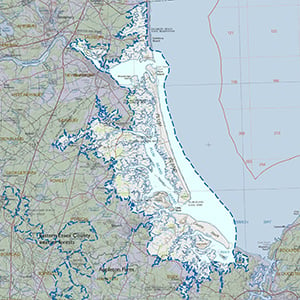Important Bird Area Sites in Massachusetts
Important Bird Area: Great Marsh
Site Summary
Nominated By
Rick Heil, Chris Leahy
Size
30,000 acres
Towns and Counties
Essex, Gloucester, Newburyport, Newbury, Rowley, Ipswich, Salisbury; Essex
Ownership
US Fish & Wildlife Service, municipal, private, Mass Audubon, The Trustees Of Reservation, Historic New England, Essex County Greenbelt Association
Major Habitats
50% salt marsh, 10% coastal beach, 10% estuarine tidal flats, 10% marine/tidal, <5% shrub-scrub wetland, palustrine woodland swamp, emergent freshwater wetland, brackish marsh, <5% river/stream, lake/pond, urban/suburban, <4% cultivated field, early successional shrubland, cultural grassland, <2% spruce-fir forest, oak-conifer forest, pitch pine/scrub oak forest, a migratory stopover site
Land Use
80% nature & wildlife conservation, 80% hunting/fishing, 95% other recreation or tourism, 95% undeveloped, 15% agriculture/livestock, 10% fisheries/aquaculture, 1-2% suburban/residential, <1% research
Serious Threats
non-native invasive plants, cowbird parasitism, succession, predators, pesticides, water pollution, excessive soil erosion/degradation, residential/commercial development, disturbance to birds or habitat, recreational development/overuse
Minor Threats
introduced animals, natural pests
IBA Criteria
- Category 1: Sites important for long-term research and/or monitoring projects that contribute substantially to ornithology, bird conservation, and/or education.
- Category 2: Sites containing assemblages of species characteristic of a representative, rare, threatened, or unique habitat within the state or region.
- Category 4: Single-species Concentrations: The site regularly supports significant concentrations of a flocking species, but may not meet the thresholds above. The site should support a higher proportion of a species' statewide population (more than 1%, if known) than other similar sites.
- Category 5: Land Birds: The site is an important migratory stopover or seasonal concentration site for migratory land birds (e.g., warblers). Sites may also qualify on the basis of supporting exceptionally high densities of breeding species as shown from point counts or other surveys or if they represent "migrant traps" relative to surrounding areas. Strong consideration will be given to areas with consistently high overall species diversity..
Site Description
The Great Marsh stretches from the New Hampshire border in the north, south to the Farm Creek estuary and salt marsh in West Gloucester, Massachusetts. To the east it is bounded by the Atlantic Ocean, and on the west by a series of glacial uplands in seven different towns. The site is essentially co-extensive with the Parker River/Essex Bay Area of Critical Environmental Concern (ACEC) and is one of the most important coastal ecosystems in northeastern North America. It is a textbook example of a barrier beach/dune/salt marsh system, in addition to encompassing the estuaries of several rivers (i.e., Essex, Ipswich, Rowley, and Parker). It is the largest contiguous stretch of salt marsh north of Long Island, and the marsh is variously dotted with many upland islands of glacial origin that are either forested or still in agricultural use. The area is rich in its diversity of characteristic species, including several that are state or federally listed. More than 300 bird species have been recorded within its boundaries. Recent extensive studies on the health of the marsh (see below) have determined that the ecosystem is currently in good shape; however, there are some significant threats to its ecological health that need to be addressed. The shoals of Ipswich Bay, and arguably the deep water beyond, are an inherent part of the adjacent coastal ecosystem and should be considered when describing this IBA.
Current Conservation Status
Several recent studies and assessments have highlighted the following threats to the health of the Great Marsh, (1) Although much of the upland within the watershed of the marsh is protected, the remaining land has either been extensively developed or is threatened with development; without continued conservation efforts and growth planning widespread degradation of the ecosystem is still a threat. (2) There are high fecal coliform concentrations in parts of the ecosystem due to inadequate sewage treatment facilities, faulty septic systems, pets, farm animals, and feral wildlife. (3) Invasive wetland plants, especially Purple Loosestrife and Common Reed are widespread, the latter stimulated by the many tidal restrictions in the area. (4) Increasing recreational use, especially by power crafts is resulting in problems with pollution from boat discharges, erosion of salt marsh banks, and disturbance of roosting and feeding birds by jet skis and speeding motorboats. (5) Anadromous fish have undergone recent declines mainly due to pollution of spawning areas and deterioration of fishways. The good news is that there is a good science-based understanding of these problems, and many private conservation organizations and government agencies in the region are working cooperatively to abate threats.
Ornithological Significance
This site is one of the most important bird areas in Massachusetts and in New England. It serves as a major concentration area for migrant waterbirds, raptors, and passerines during both spring and fall. Several federally and state-listed species breed in significant numbers, including the Piping Plover and Least Tern. Additionally, many other high-conservation-priority species have significant breeding populations here (e.g., American Black Duck, Willet, Eastern Kingbird, Brown Thrasher, Eastern Towhee, Saltmarsh Sharp-tailed Sparrow, Bobolink, and Purple Finch). Both of the predominant habitats, barrier beach and salt marsh, are comparatively scarce and of critical importance to specialized breeders and as foraging and roosting areas for a host of migrant waterbirds that seasonally occur in high-density flocks.
Other Flora or Fauna of Significance
The Massachusetts Endangered Species Act lists the following nonavian species for this proposed IBA.
Wood Turtle (special concern)
Eastern Spadefoot (threatened)
Blue-spotted Salamander (special concern)
Atlantic Sturgeon (endangered)
Shortnose Sturgeon (endangered)
Eastern Pond mussel (special concern)
Coastal Marsh Snail (special concern)
New England Siltsnail (special concern)
Persius Duskywing (threatened)
Long's Bulrush (endangered)
Engelmann's Umbrella sedge (special concern)
Hairy Wild Rye (threatened)
Seabeach Needlegrass (special concern)
American Sea-blite (special concern)
Seabeach Dock (threatened)
Silverling (endangered)
Eaton's Beggar-ticks (threatened)
Data Sources
Bird Observer records, Newburyport Christmas Bird Count, personal observations, Plum Island Hawk Watch.
Veit, R.R. and W.R. Petersen. Birds of Massachusetts. 1995. Massachusetts Audubon Society, Lincoln, MA.




